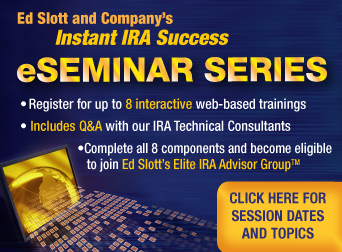
- Ed as a Speaker
- Ed Slott's IRA Advisor Newsletter
- Shopping Cart
- Discussion Forum
- IRA Resources
- IRA and Tax Tables
Assistance
PAYING THE TAX ON A ROTH CONVERSION
ESTIMATED TAX RULES WHEN INCOME INCREASES
|
The March issue of Ed Slott's IRA Advisor Newsletter goes into detail on this subject. Below are several key points to consider when dealing with the impact of a Roth conversion on estimated tax payments.
For a more detailed analysis of this subject, check out the March issue of the newsletter. |

|
Inside Ed Slott's IRA Advisor NewsletterPaying the Tax on a Roth Conversion Estimated Tax Rules When Income Increases
2010 Retirement Plan Contribution Limits If you are not already an Ed Slott's IRA Advisor Newsletter subscriber, you can preview past issues before subscribing. |
|

Q: My IRA was converted to a Roth in 2009. An RMD is required in 2010. A portion of the 2009 conversion is recharacterized in 2010. What amount is the 2010 RMD based on? A: The required minium distribution for 2010 is based on the value as of 12/31/09. Since you are doing a partial recharacterization, you will have to do 2 net income calculations, one for the recharacterization and one to determine the 12/31 value. The formula for this calculation can be found in IRS Publication 590. |
||
|
|||







